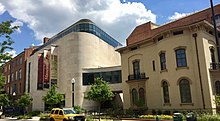Textile Museum (Washington, D.C.)
 |
|
| Former name | The Textile Museum |
|---|---|
| Established | 1925 |
| Location | Washington, DC |
| Type | Textile Museum |
| Director | John Wetenhall |
| Website | museum.gwu.edu |
The Textile Museum reopened in March 2015 as part of The George Washington University Museum and The Textile Museum on GW's main campus in Foggy Bottom. The museum was founded by collector George Hewitt Myers in 1925 and was originally housed in two historic buildings in D.C.'s Kalorama neighborhood: the Myers family home, designed by John Russell Pope, and an adjacent building designed by Waddy Wood.
The museum's mission is to expand public knowledge and appreciation – locally, nationally and internationally – of the artistic merits and cultural importance of the world’s textiles. The Museum is now housed at the George Washington University.
The Textile Museum was established in 1925 by George Hewitt Myers, a rug and textile collector and connoisseur — and was formerly housed in the building his family called home. At the time of its founding, the museum’s collection included 275 rugs and sixty related textiles, a collection Myers had built since the 1890s. Myers, a pioneer in the appreciation of handmade textiles as art and collectable objects, was drawn to the fact that non-Western textiles were the products of anonymous artists, and therefore not judged by the name or reputation of a particular person. The first objects that Myers purchased were late-nineteenth century Turkish and Caucasian village rugs, vibrant pieces with geometric designs and strong colors. As time passed and his finances allowed, Myers began to acquire a broader range of textiles, from Ottoman carpets to archeological textiles from Peru. By the second decade of his collecting, Myers methodically set out to create a comprehensive assemblage of non-Western textiles for the purpose of increasing public knowledge and appreciation of textile traditions worldwide. His intentions came to fruition in 1925, when he transformed his family home into a public institution, and his private collection into a public one.
Designed by John Russell Pope in 1913, the Myers home — now the first building that Textile Museum visitors enter — is a classical Georgian structure set in the Kalorama neighborhood of Washington, D.C. The museum’s galleries are housed in an adjacent building, which was designed by Washington architect Waddy Wood and purchased by Myers in 1915 for this purpose. Large gardens behind the buildings are open to the public during museum hours.
...
Wikipedia
